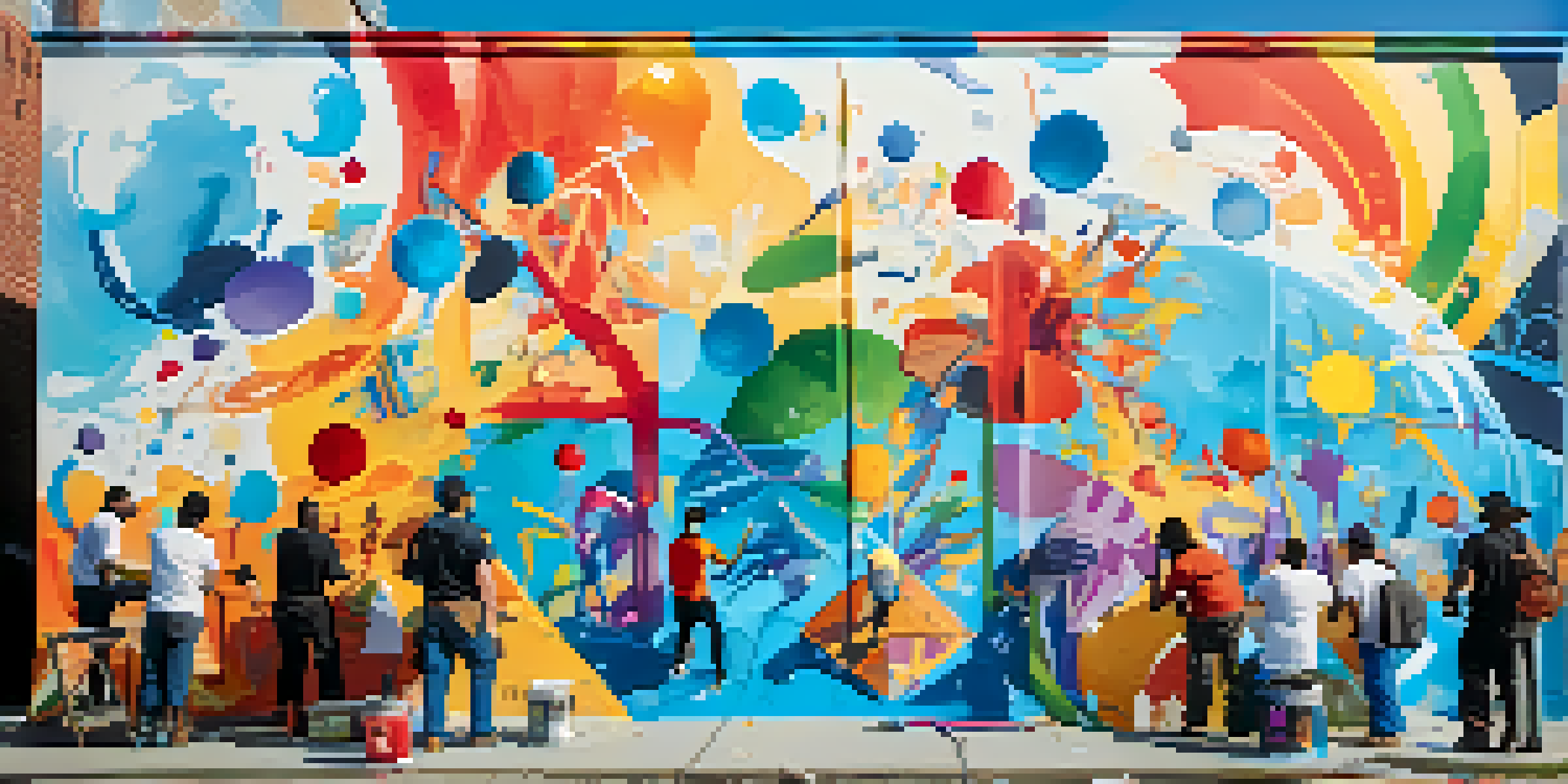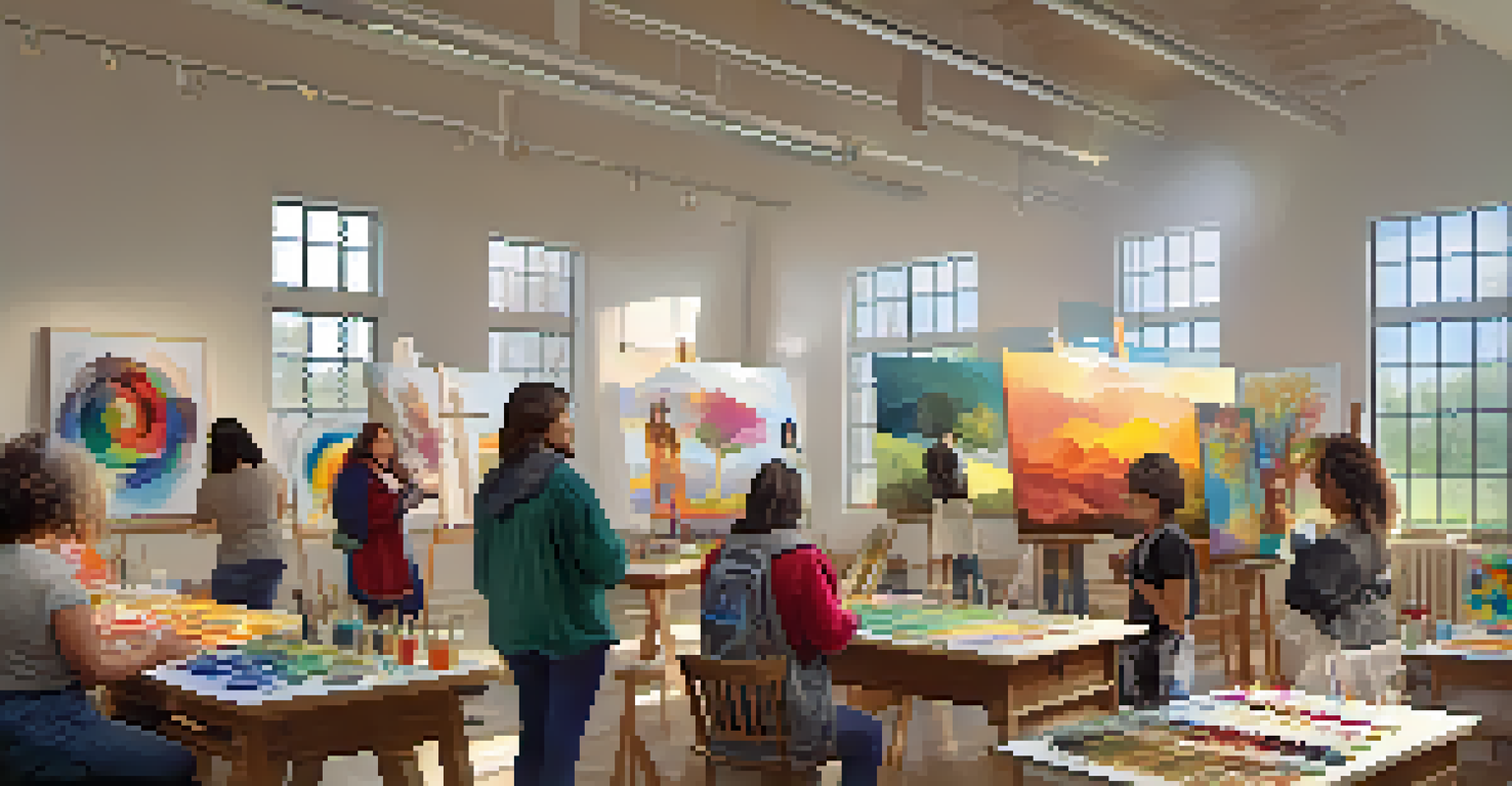Community Arts Programs Enhancing Creativity in Colorado

The Role of Community Arts in Fostering Creativity
Community arts programs serve as a catalyst for creativity, providing individuals with the opportunity to explore their artistic potential. These programs often include a range of activities, from painting and sculpture to music and theater, making the arts accessible to everyone. By engaging in creative pursuits, participants not only hone their skills but also experience a sense of accomplishment and self-expression.
Art is not freedom from discipline, but disciplined freedom.
Moreover, these programs encourage collaboration among community members, fostering a sense of belonging and connection. When people come together to create, they share ideas and perspectives that enrich the artistic experience. This collaboration can lead to innovative projects that might not have been possible in isolation, showcasing the power of collective creativity.
Ultimately, community arts programs create an environment where creativity thrives, allowing individuals to tap into their unique talents. As participants engage with the arts, they often discover new passions and interests, which can lead to lifelong pursuits. This nurturing of creativity not only benefits the artists but also enriches the community as a whole.
Examples of Successful Community Arts Programs in Colorado
Across Colorado, numerous community arts programs exemplify the impact of creativity on local culture. For instance, the Denver Arts & Venues initiative offers a variety of workshops and events aimed at engaging the community in artistic endeavors. These initiatives often attract diverse groups, fostering an inclusive atmosphere where everyone feels welcome to participate.

Another shining example is the Boulder Arts Council, which provides funding and resources for local artists and community projects. By supporting artists in their quest to create public art, the council enhances the cultural landscape of Boulder, making the arts a vital part of everyday life. This investment in the arts not only beautifies the community but also inspires residents to engage with art on a personal level.
Community Arts Foster Creativity
Community arts programs provide individuals with opportunities for self-expression and collaboration, enhancing creativity and connection.
These programs not only showcase local talent but also drive tourism and economic growth. Visitors are drawn to Colorado's vibrant arts scene, contributing to a thriving local economy. As more communities develop similar initiatives, the ripple effect of creativity will continue to strengthen Colorado's identity as an arts-rich state.
Building Connections Through Collaborative Art Projects
Collaborative art projects are a powerful way to bring people together and foster creativity within communities. These projects often involve participants from various backgrounds working together towards a common artistic goal. Whether it's a mural, a community garden, or a theater production, the shared experience of creating something meaningful can strengthen bonds among participants.
Creativity takes courage.
For instance, community mural projects not only beautify public spaces but also engage local residents in the creative process. As individuals contribute their ideas and skills, they develop a sense of ownership and pride in the final product. This sense of belonging can lead to increased community cohesion, as people come together to celebrate their collective achievement.
Moreover, collaborative projects often encourage dialogue and understanding among participants. When individuals from different walks of life come together to create, they have the chance to share their stories and perspectives. This exchange can foster empathy and inspire deeper connections, making the community stronger and more resilient.
Art as a Tool for Personal Development
Engaging in community arts programs offers valuable opportunities for personal development. Participants often find that artistic expression can be a powerful outlet for emotions and thoughts. Whether through painting, music, or drama, individuals can explore their inner selves and communicate their experiences in a creative way.
In addition to emotional growth, participating in arts programs can boost confidence and self-esteem. As individuals develop their skills and receive positive feedback from peers, they begin to see themselves as capable creators. This newfound confidence can extend beyond the art studio, impacting other areas of life such as work and relationships.
Importance of Arts Education
Integrating arts education in schools cultivates critical thinking and emotional expression, paving the way for future creative careers.
Furthermore, the discipline required to hone artistic skills can translate into other pursuits. Participants learn the importance of practice, patience, and perseverance—qualities that are essential for success in any field. By fostering personal growth through the arts, community programs contribute to the development of well-rounded individuals.
The Impact of Arts Education in Schools
Arts education plays a critical role in enhancing creativity and innovation in schools throughout Colorado. By integrating the arts into the curriculum, educators help students develop critical thinking and problem-solving skills. These skills are essential for success in today’s rapidly changing world, where creativity is increasingly valued across all industries.
Additionally, arts education encourages students to express their unique perspectives and feelings. Whether through visual arts, music, or theater, students learn to communicate their ideas effectively. This ability to articulate thoughts and emotions can lead to improved academic performance and greater overall engagement in school.
Moreover, exposure to the arts can inspire students to pursue careers in creative fields. As they discover their passions through arts education, they may choose to further their studies in areas such as graphic design, performing arts, or art therapy. By nurturing creativity in schools, we are investing in the future of the creative workforce.
The Role of Local Governments in Supporting Arts Programs
Local governments in Colorado play a crucial role in supporting community arts programs. By providing funding, resources, and infrastructure, they help ensure that arts initiatives can thrive. Grants and sponsorships can make a significant difference for small organizations, enabling them to offer diverse programming that serves the community's needs.
In addition to financial support, local governments often collaborate with arts organizations to promote cultural events and activities. This partnership can amplify the visibility of the arts within the community, attracting more participants and fostering a sense of pride in local talent. When communities see their government prioritizing the arts, it encourages greater public engagement.
Local Governments Support Arts
Local governments play a vital role in funding and promoting arts programs, which boosts community engagement and economic growth.
Furthermore, investing in the arts can have economic benefits for local governments. A vibrant arts scene can attract tourism, create jobs, and stimulate local businesses. By recognizing the value of arts programs, local governments can play an instrumental role in enhancing the cultural landscape and overall quality of life in their communities.
Future Trends in Community Arts Programs
As we look to the future, community arts programs in Colorado are evolving to meet the changing needs of society. One emerging trend is the integration of technology in arts initiatives, allowing participants to explore new mediums and forms of expression. From digital art workshops to virtual performances, technology is opening up exciting possibilities for creative engagement.
Additionally, there is a growing emphasis on inclusivity and diversity within community arts programs. Organizations are making concerted efforts to reach underserved populations and ensure that everyone has the opportunity to participate. By fostering an environment that values diverse voices and perspectives, these programs can enrich the creative landscape and strengthen community bonds.

Finally, sustainability is becoming a key focus for many arts programs. By prioritizing eco-friendly practices and materials, organizations are not only reducing their environmental impact but also inspiring participants to think critically about their relationship with the planet. This forward-thinking approach ensures that community arts programs remain relevant and impactful for generations to come.